Tunnelizing Migration 1: The Border Tunnel Capital of North America
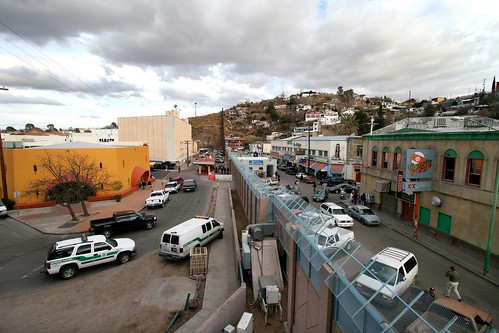
[Image: Nogales, Arizona. Photo by Sgt. 1st Class Gordon Hyde January 30, 2007.]
As you may or may not know Nogales, Arizona has quickly become the border tunnel capital of North America, as in illegal cross-border tunnel, at least as far as the U.S. government can tell. The latest numbers according to a NORTHCOM Task Force briefing that was apparently secretly leaked over the web just weeks ago, indicate between 1990 and November 2008, 93 cross-border tunnels were discovered, 35 of which were in California, 57 in Arizona, and 1 in Washington State.
I’ve been watching this incessantly, tunnels breaching the US-Mexico border have been percolating in the news for the last couple years sometimes at nearly a new story every week – or, a new discovery, rather. At fascinating pace.
In addition to a brand new smuggling tunnel found just a few days ago a quarter-mile east of the Otay Mesa Port of Entry in California – a “3-foot-wide by 3-foot-tall, wood-reinforced channel without lighting or ventilation equipment” believed to connect to a deactivated natural-gas pipe running underneath the boundary – the Border Patrol out of Tucson announced the finding of three more tunnels in Nogales from Dec.-Jan. '08-'09 all tapping into existing storage drains and shared sewage canals, or dipping under the fence.
Two weeks ago in San Ysidro, a coyote was busted trying to lead a small group of people “down a dangerous 30-foot storm drain” south of the South Bay International Wastewater Treatment Plant “to avoid detection while furthering their entry into the country through a near flooded drainage tube.” People were injured, caught – not pretty.
As of October last year, I think the number of tunnels found in Arizona (Nogales, mostly) is at least twelve, maybe fifteen now. That’s somewhere between two and three tunnels discovered every month there in the last five.
While cities in California shake with regular earthquakes, Nogales at its own rate gets plowed by border tunnels.

[Image: From US NORTHCOM Task Force Briefing, 2008/09.]
Looks like the multi-billion dollar border fence aint working so well after all – what a surprise. In fact it seems to be causing as much disaster as it claims to be trying to prevent, evidenced in nearly every environmental impact review you will read of the fence (not to mention the DHS waived of over thirty environmental protection laws to build it). FAS recently pointed out that the proliferation of tunnels dug underneath the border had been casually categorized as an unintended consequence in a Congressional Research Service report (pdf) drafted last year.
You think? Come on, unintended? That’s such a bureaucratically passive way of putting it. Tunneling was hardly an unanticipated response to the fence – unintended (well, no shit) – the language sounds so desperately oblivious to me…sorry, but in an almost purposeful state of denial. Or, perhaps the Congress is just that plainly clueless about the situation. The researchers in the report go on to suggest:
A possible issue for Congress to consider as it debates expanding the existing border fencing is what the unintended consequences of this expansion could be. Given the re-routing of migration flows that have already occurred, are DHS and the relevant border communities prepared to handle the increased flow of illegal migration to non-reinforced areas? Is DHS prepared to deal with an increase in the phenomenon of cross-border tunnels and other attempts to defeat the purpose of the fencing? What will the impact on crime rates be along the unreinforced areas of the border? Will USBP agents be required to spend some of their patrolling time guarding the fence? - (Border Security: Barriers Along the U.S. International Border, CRS Report for Congress, Order Code RL33659, Updated May 13, 2008)
Sounds like questions that should have been answered long before the fence was even started. Since its construction kicked into real gear a few years ago tunnels have sprung up everywhere along the southern border like leaks bursting in the stern of the USS Fortress America – which is only predictable. The DHS has in the past tried to use the detection of tunnels as proof the fence and other measures are working by driving the traffickers into more desperate zones of operation, which would corroborate the Congress’ research had they instead said the tunnels were a precisely intended outcome of the fence.
It’s the ‘show me a ten foot fence and I’ll show you an eleven foot ladder’ neologism making an even bigger nuisance of the fence’s impotence here via the tunnel. At this point, if the only thing you can say about close to 100 secret tunnels manifesting along your border in the last two decades is that they are an unintended consequence, then it just goes to show how out of touch the Congress is with the reality of a border fence altogether, since the fence is what primarily put them there. Not as if that point needs to be belabored any further – the fence is a complete waste in every aspect.
All you silly future security fence engineers out there take note – prepare for tunnels!
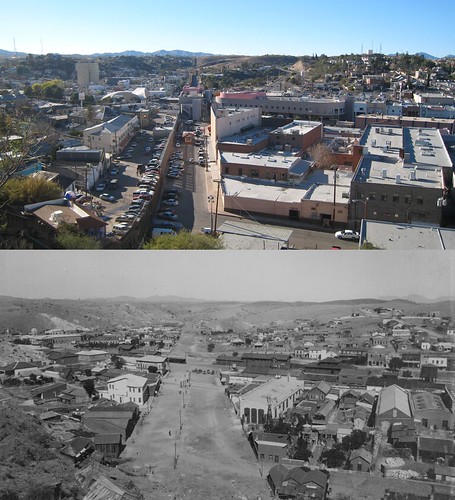
[Image: "The town of Nogales is split down the middle by the US/Mexico border. In these pictures Mexico is on the left, and the US is on the right. In 1898 you could cross anywhere. Now there is a 15 foot high wall and border patrol agents every 50 yards." - via think or thwim.]
If tunnels are being dug, or spatially hacked into and out of existing drainways (at least fifteen in the last few months), then the only thing proving successful to me is the illicit tunnel industry itself. The reality is that some of the tunnels were already there prior to the fence (some that latched onto preexisting infrastructure underground) while others were built as border security revved to full speed. There is no way of knowing how many tunnels have or still exist today, or for how long.
The Ambos Nogales wash is an old project that has been crawling with people probably ever since it was built, notably with the tunnel communities in the nineties, but more so today with coyotes and smugglers – explored in an earlier subtopes’ post Orwellian Wormholes. The BP wasn’t even really looking for this sort of thing until after 9/11.
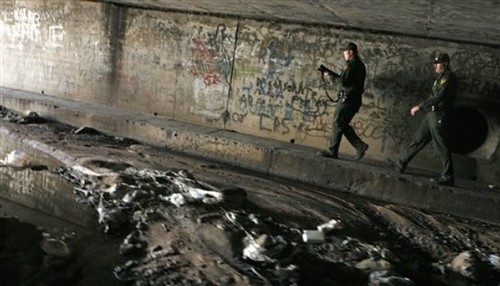
[Image: "April 5, 2007, near the exit of the Grant Tunnel in downtown Nogales, Ariz., which connects to drainage systems in Mexico. The tunnel was one of two storm drain tunnels constructed by the Army Corps of Engineers in order to alleviate flooding in the area." - AP Photo by James Gregg.]
The watershed infrastructure and all its subset tunnels that wander under Nogales on both sides of the border are so vast perhaps the only way to truly gage the number of secret unaccounted-for passages that poke, spoke, and meander through it would be to airlift the entire structure (at the core two parallel concrete tunnels roughly fifteen feet wide and several miles long), scooping and dislodging it and plenty of surrounding earth (houses, city sewage tunnels and all) from its site fixed under the border, and dunking into some sort of nearby tank the size of at least twenty square city blocks filled with liquid foam core, then to delicately remove the infill tendrils later and see what extracted void sculpture you might be able to use to extrapolate a visualization of the smaller informal tunnels that violate the whole thing.
If anything it might make for one hell of a sculpture. When we’re finished we could just lay it out somewhere in the desert heaped over another part of the border like the fleeting corpse of some post-urban horror show that almost escaped the border’s relentless persecution of its soul -- border tunnels leaping from their own skin as installation art.
Or, you dunk the sewage skeleton into a manmade lake filled with fearless fish you’ve attached with GPS units, and using water hoses in strategic directions encourage them to swim through it like good little geographers to map a new home out of the kidnapped hydrology, tracking their movements while illuminating the kelpy tangles of the structure’s smuggler lungs.

[Image: "Construction crews work on the Arroyo Boulevard covered channel over the Nogales Wash. The tunnel houses the wash as it runs from downtown Nogales, Sonora, into Nogales, Arizona. The wash water has been found to contain raw sewage and industrial chemicals." Photos by Jeffry D. Scott. / Bridging Troubled Waters in Ambos Nogales by Miriam Davidson.]
Actually, it makes more sense to probably just evacuate thousands of good neighboring border folk from their homes in Nogales today and flood it where it is now to achieve the same effect, which might just happen on its own one day if it hasn’t already, no thanks to the border fence, ironically enough.
Impossible as any of that may be right now, even though there wasn’t anything close to 650 miles of southern border barricade back in 1990 when construction on the fence really just began in San Diego, it certainly doesn’t mean cross-border tunnels didn’t exist for smuggling or migration (most probably in urban areas of sister cities), or were they any less a reality. Fence, or no fence, US-Mexico border tunnels allegedly date back to at least the days of Prohibition. But, throw in a high-tech surveillance fence, and the tunnels truly get to do their thing, much like they did in Berlin and Sarajevo, for example – the tunnels get to fulfill their own ideal destinies skirting the constraints of uber power.

[Image: Drug Smugglers Tunnel Discovered At Border Tunnel Otay Mesa.]
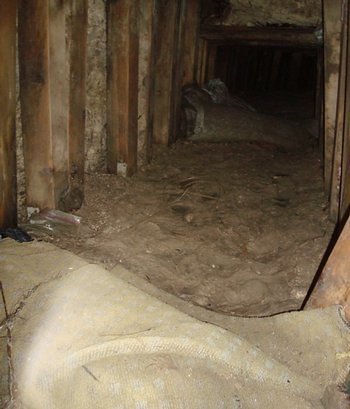
[Image: Border Patrol discovers underground tunnel in Otay Mesa.]

[Image: Two tunnels found under border at Nogales, January 20th, 2009.]
The DHS, like it or not, has instigated an era along the US-Mexico border where the tunnel works of cartels and traffickers are and will more than likely continue to thrive, at least for awhile, probably a good long while. Just look what the closed borders sealing Gaza have done for the tunneling industry there, with virtually no resources to work with at all, butted up against one of the most high-tech militaries on the planet. The IDF continues bombing them today, yet the underground conduits of Gaza’s dark survival continue.
Well, the cartels have full-on engineering companies at their disposal armed to the teeth with the latest equipment and weapons, not to mention their own militaries vying for control of Mexico’s sovereignty right now.
The fence is all the invitation a good old-fashioned tunnel needs. While the fence is the superpower precondition for the tunnel supremacy of asymmetric warfare, the tunnel is the prototypical space of imperial bypass – a primal blueprint that has succeeded since the dawn of war, most prominently where barriers have tried to endure. They are locked in a sort of immortal embrace there on the fringes of the border.
This is intimately curious to me, the relationship the fence and tunnel share, where the spatial dynamics of territorial authority are built up and broken down again, are constantly uprooted and re-challenged, where the limits of power are undone by the primordial urge to human ingenuity persistent in its crudest form, in its naked right to move freely beyond all constraints and survive, snoop, escape, evade, profit. As a fracture in the integrity of the nation-state landscape the border is such an intriguing and precarious vista to look at the (geo)politics of space where it is just sort of cast there in the soil, in a line and a fence’s shadow – in the hollows of what refuses to be noticed. Spatial fallout.
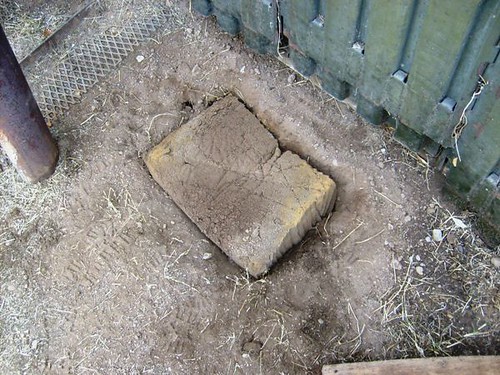
[Image: Tunnel found next to border fence in Nogales.]

[Image: Border Patrol Foils Underground Smuggling Ploy.]
It make me wonder about what the DHS strategy really has been: obviously, features like the fence are intended to slow down and displace the flows of migration to areas that are more difficult to traverse (like the desert and the underground, or into coastal waters), but if you’re going to drive it in to these places then you shouldn’t act too surprised when it actually turns up there, or as if this was somehow an unintended outcome.
The DHS must have known precisely the tunnels would come into play, and perhaps that was the intention all along: to use the border fence in order to remove the mass migration problem from plain view; to blur and peripheralize, or, even tunnelize migration by forcing it into the narco-corridors of violent and illegal drug trafficking – which not only helps make “unauthorized” border crossing all the more criminalizeable, or especially perilous for border-crossers, but it buys the government a little extra time before they have to face a new wave of public objection to the rotted immigration system in the U.S.. Further, it exposes the border fence all the more for the shortsighted and shoddy policy of patch-jobs, wishful fortification, and pricey spectacular surveillance ‘theater’ that it is catering to the defense and prison industry, and paranoiac fears over national security. The tunnels have only linked the issue of migration with the political violence of the 'War on Drugs' as a very irresponsible consequence of the fence. So, now that your fence has created a vault of underground tunnels what's the next winning strategy -- if there is such a thing, besides....total policy reform? (Hold that thought).
Tunnelizing Migration 2, coming.







3 Comments:
Nice reportage there.
This tunnel system, it looks like the next Cu Chi to me. And that's not good at all. 'Paranoiac fears' aside, of course.
"Looks like the multi-billion dollar border fence aint working so well after all – what a surprise."
I have always considered the border fence to be more a political tool and a means by which to perpetuate the prison industrial project. Imagine how much these fence building contracts are worth and then throw in the detention areas and all the gear for Border Patrol. Obviously somebody is getting rich off of this, I mean besides coyotes and drug runners.
Another great post, keep it up.
Enjoyed this post a lot. Thanks.
-Alex
Post a Comment
<< Home